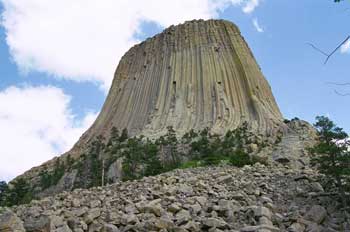Devils Tower Geology
Devils Tower rises above the surrounding grassland and Ponderosa pine forests like a rocky sentinel. Northern Plains tribes worshipped at this remarkable geologic formation long before white men wandered into the West, and fur trappers, explorers, and settlers alike were awed by the Tower's majesty. In 1906, President Theodore Roosevelt established Devils Tower as our nation's first national monument. Many have gazed at the Tower and wondered, "How did this amazing formation get here? How did it form?"
The Stage is Set
Most of the landscape surrounding Devils Tower is composed of sedimentary rocks. These are rocks which are formed from broken or dissolved fragments of other rocks and are usually deposited by water or wind.
The oldest rocks visible in Devils Tower National Monument were laid down in a shallow sea during the Triassic time, 225 to 195 million years ago. This dark red sandstone and maroon siltstone, interbedded with shale, can be seen along the Belle Fourche River. Oxidation of iron minerals causes the redness of the rocks. This rock layer is known as the Spearfish formation.
Above the Spearfish formation is a thin band of white gypsum, called the Gypsum Spring formation. This layer of gypsum was deposited during the Jurassic time, 195 to 136 million years ago.
Seas retreated and returned. Climates changed and changed again. Gray-green shales (deposited in low-oxygen environments such as marshes) were interbedded with fine-grained sandstones, limestones, and sometimes thin beds of red mudstone. This composition, called the Stockade Beaver member, is part of the Sundance formation.
The Hulett Sandstone member, also part of the Sundance formation, is composed of yellow fine-grained sandstone. Resistant to weathering, it forms the nearly vertical cliffs which encircle the Tower itself.
Seas again retreated and advanced. Landforms were eroded; new sediments were deposited. About 65 million years ago, during the Tertiary time, pressures within the earth climaxed, uplifting the Rocky Mountains and the Black Hills. Molten magma welled up toward the surface of the earth, intruding into already-existing sedimentary rock layers.
The Tower is Formed: an Ongoing Debate
Geologists agree that Devils Tower was formed by the intrusion (the forcible entry of molten rock into or between other rock formations) of igneous material. What they cannot agree upon is how, exactly, that process took place!
Numerous theories have evolved since the official discovery of Devils Tower. Geologists Carpenter and Russell studied Devils Tower in the late 1800s and came to the conclusion that the Tower was indeed formed by an igneous intrusion. Later geologists searched for further explanations.
In 1907, scientists Darton and O'Hara decided that Devils Tower must be an eroded remnant of a laccolith. A laccolith is a large mass of igneous rock which is intruded through sedimentary rock beds but does not actually reach the surface, producing a rounded bulge in the sedimentary layers above. This theory was quite popular in the early 1900s since numerous studies had earlier been done on a number of laccoliths in the Southwest.
Other theories have suggested that Devils Tower is a volcanic plug or that it is the neck of an extinct volcano (an unlikely theory, for there is no evidence of volcanic activity - volcanic ash, lava flows, or volcanic debris - anywhere in the surrounding countryside)!
No one yet has a definite answer as to how exactly Devils Tower was formed - other than that it was an igneous intrusion into the sedimentary layers above and that the molten rock comprising the Tower did not surface. In any case, geologists agree, the igneous material intruded and then cooled as phonolite porphyry, a light to dark-gray or greenish-gray igneous rock with conspicuous crystals of white feldspar. As the lava cooled, hexagonal (and sometimes 4-, 5-, and 7-sided) columns formed. As the columns continued to cool, vertical cracks developed as the columns shrank horizontally in volume.
The Tower is Uncovered
Until erosion began its relentless work, Devils Tower was not visible above the overlying sedimentary rocks. But the forces of erosion - particularly that of water - began to wear away the sandstones and shales. The much harder igneous rock survived the onslaught of erosional forces, and the gray columns of Devils Tower began to appear above the surrounding landscape.
As rain and snow continue to erode the sedimentary rocks surrounding the Tower's base, and the Belle Fourche River carries away the debris, more of Devils Tower will be exposed. But at the same time, the Tower itself is slowly being eroded. Rocks are continually breaking off and falling from the steep walls. Rarely do entire columns fall, but on remote occasions, they do. Piles of rubble - broken columns, boulders, small rocks, and stones - lie at the base of the Tower, indicating that it was, at some time in the past, larger than it is today.
Eventually, at some time far in the future, even Devils Tower itself will be eroded away
